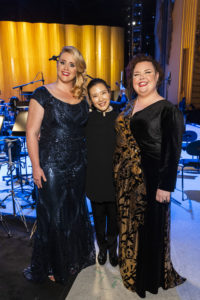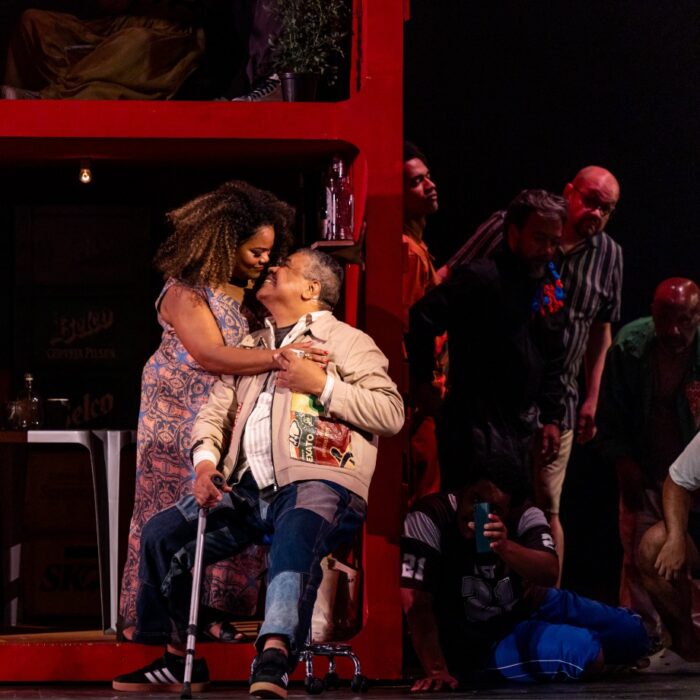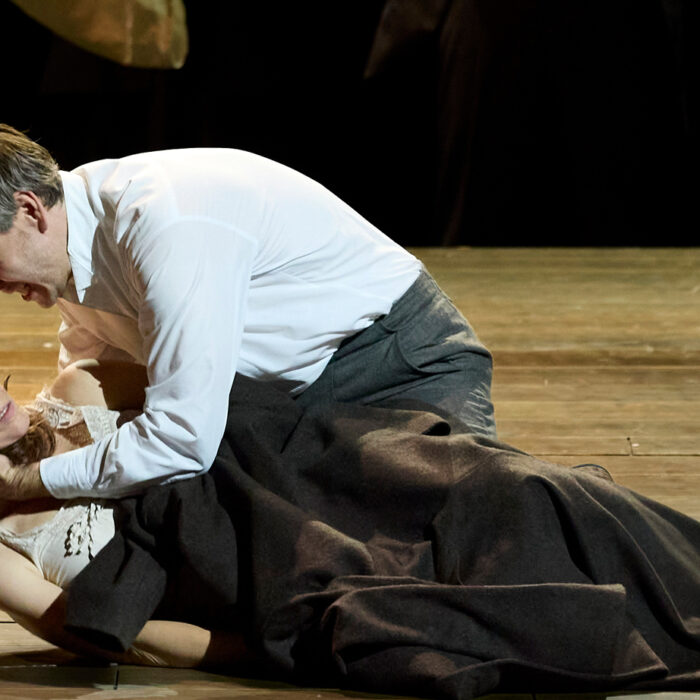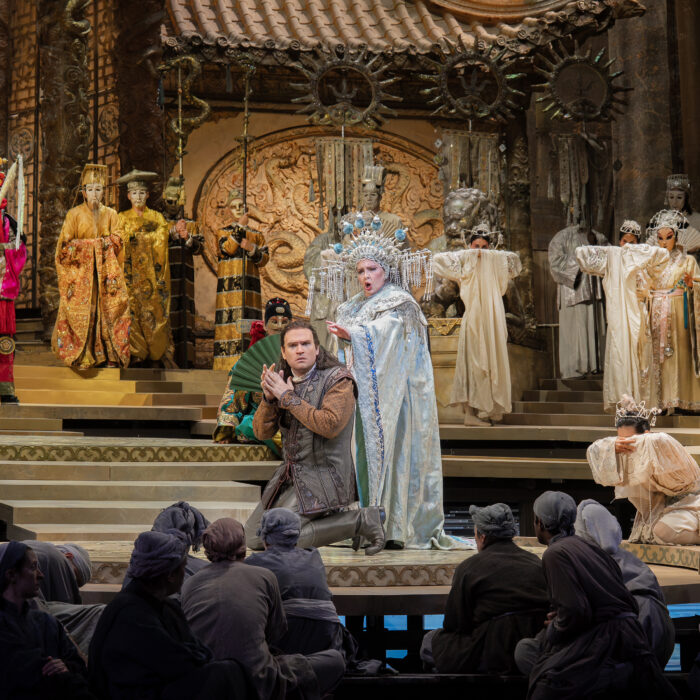
San Francisco Opera 2021-22 Review: Live and In Concert: The Homecoming
Jamie Barton, Rachel Willis-Sørensen, Eun Sun Kim Welcome Audiences Back
By Lois Silverstein(Credit: Cory Weaver/San Francisco Opera)
Sunlight on the water, fog hovering. Homecoming at the Opera House, San Francisco September 2021. “Finalmente! Finally.” Masked and vaccinated we arrive at the doors of the War Memorial Opera House and are welcomed as if we are the stars. In a way we were: the ones who up until tonight, could not enter. The ones whose fees were unacceptable because we could bring contagion, danger, Covid. Too high a price, even for high art. But not tonight. (No applause, please; we only did what we could.)
Thankfully, we were now able to take our seats, and wait for the music to begin: Eun Sun Kum, San Francisco’s new music director, the San Francisco Opera Orchestra, two singers “extraordinaire,” Rachel Willis-Sørensen, soprano, Jamie Barton, mezzo-soprano. The concert that kicked off the season to come as well as welcomed audiences back. To make it more San Francisco? They added a live transmission to San Francisco’s Oracle Stadium, Home to the San Francisco Giants Baseball Team. A true San Francisco Happening? We should say so.
The program consisted of two acts, each featuring at least one orchestral piece conducted by Eun Sun Kim, and individual arias by each of the sopranos and several duets. Before the official concert began, Kim struck up the National Anthem, in observance of the 9/11 memorial event upcoming. From the start, Kim conducted with vigor and vitality, leaving nothing behind. From the moment she sprinted onto the stage and the podium, she was in business, her petite frame showing nothing petite in her conducting control and liveliness, Von Suppé’s “Light Cavalry” kicked things off, and as an old chestnut, it provided a light but necessary link to our musical heritage and what we are reestablishing now. The concert was dubbed “The Homecoming” for important reasons. The new builds from the old.
Rachel Willis-Sørensen began with Verdi’s “Sempre Libera” from “La Traviata,” in a polished and poised rendition. Dramatized and nuanced, she took the stage and let Violetta’s story unfold in few minutes. Her range of mood and feeling was carefully sculpted, poignant, reflective, temperate, doubtful, then snap! The famous toss-off – Love? Nonsense. I am free as a bird and will remain so, her rich and voluminous voice lightening as bird’s wing and soaring. This aria introduced as well the second thematic motif of the concert: love, and especially women’s love, who loves, who should, who shouldn’t, and how women deal with it. When Jamie Barton, bespangled in silver, came on stage to much favorable applause, she picked up the theme with Donizetti’s lovely aria, “O mon Fernand” from Donizetti’s “La Favorite.” Pleading, poignant, melancholic, but with Barton’s characteristic verve, the music unfolded and slid through the air with aplomb. Although at first the French text tamed some of Barton’s “frisson,” by the cabaletta, it sprang forth.
The two performers alternated solos for the next two numbers, again accenting the theme of women in love – “Louise” by Charpentier, and the torrid “O Don Fatale” by Verdi, from “Don Carlo.” The passionate duet between Jane Seymour and Anne Boleyn from Donizetti’s “Anna Bolena” capped the Act off, Sørenson’s proud and defiant Anna, sung with intensity and vigor, her low tones perfectly struck as her emotion jockeyed her into confrontation, Barton’s Seymour deliberate in her admission of guilt, and pearl-like tones expressing her contrition. The duet was an excellent technical display of each singer’s vocal and emotional ranges. The powerhouse bel canto sound and musicality, fastidious dramatic expression brought the “house” down on Act one. The two women joined in their denunciation of the King whose appetite brought them from rivalry into an alliance. The English translation of their joined forces opened the door to their agreement: “These embraces is just the first of his torments.”
This love theme develops further in Act two, which opened with a duet between Amneris and Aida, from Verdi’s ‘Aida’, the two rivals once confronting their competition for the love of Rhadames, then again joining forces and becoming allies. The beauty of the two female voices, arcing and pleading, angry and confronting, the melodious tonalities turning them from opposition to unity strengthen the emotional bond the two powerful and lustrous voices created. Sørensen’s full-bodied upper register, the ease of her descent, and the voluminous low tones transmitted the wealth of her commitment to what she, Anna Bolena, felt. Barton’s range was equally flexible and fresh, the dark richness of her low range and the ease with which she sculpts the air with her middle and high tones gave her Jane Seymour a liveness and litheness that made their story viable.
The message couldn’t be more clear: women, conditioned to oppose each other, particularly with respect to a man in love, can and do, join together in friendship through consideration and compassion. When Sørensen sang her Pietà, the touching delicacy of her sound brought us to the impassioned plea for women’s companionship rather than competition. Maestra Kim’s leadership of the orchestra provided an additional dimension. Their music was exquisite.
The last third of the concert had the Orchestra play from Dvořák’s “Rusalka,” exceptional Brass favored in a nice contrast to the Verdi. Sørensen’s rendition of the “Song to the Moon,” from the same opera, deftly sung in Czech, accented the freshness of the character of Rusalka herself, a new world, a new vista emblemized in her tender request. The moody blue-green lighting created a perfect atmosphere for it.
One special highlight was Barton’s rendition of Saint-Saëns “Mon Coeur s’ouvre à toi” from “Samson et Dalila.” From the reddish-gold lights surrounding her to the sumptuous, luxurious tones Barton spun out, the music became rapture. She held her own as she held her pose. She stood open and revealed, she caressed the words as she would caress her Samson, and Saint-Saëns created a tonal and human masterpiece. Her voice shimmered and sank into depths of growing passion. She proffered such ardent feeling, the vintage-sounding deep tones and the powerful upper register, made her seem Dalila “assoluta.” It was as if Barton allowed herself to be seen and felt.
The climax of Act two was the Orchestral sweep and contrapuntal instrumentation of Strauss’s ‘Capriccio’ followed by a stunning performance from Donizetti’s “Norma” by Willis – Sørensen and Barton. Here we had parallel feelings emerging from their distinct and distinctive voices, as rivals in love, who speak their feelings and declare loving friendship for each other. The tenderness as well as the loss brought them both alive as any two women in such a situation might be. A brilliant and bountiful contribution to the musical richness of the evening and its thematic statement about women who bond together rather than suffer apart. There were no step sisters here.
With the Encore of the medley of Carousel’s “You’ll Never Walk Alone,” and “Climb Every Mountain” sung by the two women, playing with fluidity and grace by the orchestra under Maestra Kim, we left the War Memorial Opera House clearly ready to breathe in the possibilities of the life of music in the city once again. In spirit and execution, “The Homecoming Concert” opened the doors to the oncoming season, lovingly and respectfully. We left in gratitude.


